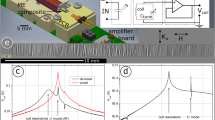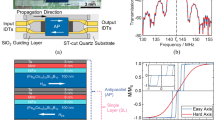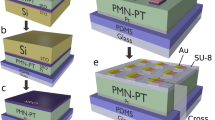Abstract
Magnetoelectric composite materials are promising candidates for highly sensitive magnetic-field sensors. However, the composites showing the highest reported magnetoelectric coefficients require the presence of external d.c. magnetic bias fields, which is detrimental to their use as sensitive high-resolution magnetic-field sensors. Here, we report magnetoelectric composite materials that instead rely on intrinsic magnetic fields arising from exchange bias in the device. Thin-film magnetoelectric two–two composites were fabricated by magnetron sputtering on silicon-cantilever substrates. The composites consist of piezoelectric AlN and multilayers with the sequence Ta/Cu/Mn70Ir30/Fe50Co50 or Ta/Cu/Mn70Ir30/Fe70.2Co7.8Si12B10 serving as the magnetostrictive component. The thickness of the ferromagnetic layers and angle dependency of the exchange bias field are used to adjust the shift of the magnetostriction curve in such a way that the maximum piezomagnetic coefficient occurs at zero magnetic bias field. These self-biased composites show high sensitivity to a.c. magnetic fields with a maximum magnetoelectric coefficient of 96 V cm−1 Oe−1 at mechanical resonance.
This is a preview of subscription content, access via your institution
Access options
Subscribe to this journal
Receive 12 print issues and online access
$259.00 per year
only $21.58 per issue
Buy this article
- Purchase on Springer Link
- Instant access to full article PDF
Prices may be subject to local taxes which are calculated during checkout




 .
.



Similar content being viewed by others
References
Ma, J., Hu, J., Li, Z. & Nan, C-W. Recent progress in multiferroic magnetoelectric composites: From bulk to thin films. Adv. Mater. 23, 1062–1087 (2011).
Dong, S., Cheng, J., Li, J. F. & Viehland, D. Enhanced magnetoelectric effects in laminate composites of Terfenol-D/Pb(Zr,Ti)O3 under resonant drive. Appl. Phys. Lett. 83, 4812–4814 (2003).
Laletin, V. M. et al. Frequency and field dependence of magnetoelectric interactions in layered ferromagnetic transition metal-piezoelectric lead zirconate titanate. Appl. Phys. Lett. 87, 222507 (2005).
Srinivasan, G. et al. Magnetoelectric bilayer and multilayer structures of magnetostrictive and piezoelectric oxides. Phys. Rev. B 64, 214408 (2001).
Greve, H., Woltermann, E., Quenzer, H-J., Wagner, B. & Quandt, E. Giant magnetoelectric coefficients in (Fe90Co10)78Si12B10-AlN thin film composites. Appl. Phys. Lett. 96, 182501 (2010).
Tadahiko, K. & Isao, S. Self bias magnetostrictive material. Japanese patent 09083037 A (1997).
Mandal, S. K., Sreenivasulu, G., Petrov, V. M. & Srinivasan, G. Flexural deformation in a compositionally stepped ferrite and magnetoelectric effects in a composite with piezoelectrics. Appl. Phys. Lett. 96, 192502 (2010).
Onuta, T-D. et al. Energy harvesting properties of all-thin-film multiferroic cantilevers. Appl. Phys. Lett. 99, 203506 (2011).
Vopsaroiu, M., Blackburn, J. & Cain, M. G. A new magnetic recording read head technology based on the magneto-electric effect. J. Phys. D 40, 5027–5033 (2007).
Meiklejohn, W. & Bean, C. New magnetic anisotropy. Phys. Rev. 105, 904–913 (1957).
Nogués, J. & Schuller, I. K. Exchange bias. J. Magn. Magn. Mater. 192, 203–230 (1999).
Van Driel, J., de Boer, F. R., Lenssen, K-M. H. & Coehoorn, R. Exchange biasing by Ir19Mn81: Dependence on temperature, microstructure and antiferromagnetic layer thickness. J. Appl. Phys. 88, 975–982 (2000).
Li, H. et al. Exchange enhancement and thermal anneal in Mn76Ir24 bottom-pinned spin valves. J. Appl. Phys. 89, 6904–6906 (2001).
Kantola, M. & Tokola, E. X-ray studies on the thermal expansion of copper–nickel alloys. Ann. Acad. Sci. Fennicae Ser. A6: Physica 223, 1–10 (1967).
Ellis, W. C. & Greiner, E. S. Equilibrium relations in the solid state of the iron–cobalt system. Trans. Am. Soc. Metals 29, 415–432 (1941).
Hu, J-g., Jin, G-J. & Ma, Y-Q. Thickness and angular dependencies of exchange bias in ferromagnetic/antiferromagnetic bilayers. J. Appl. Phys. 92, 1009–1013 (2002).
Camarero, J. et al. Origin of the asymmetric magnetization reversal behavior in exchange-biased systems: Competing anisotropies. Phys. Rev. Lett. 95, 057204 (2005).
Greve, H. et al. Low damping resonant magnetoelectric sensors. Appl. Phys. Lett. 97, 152503 (2010).
Williamson, S. J. & Kauffmann, L. Biomagnetism. J. Magn. Magn. Mater. 22, 129–201 (1981).
Dho, J. & Blamire, M. G. Competing functionality in multiferroic YMnO3 . Appl. Phys. Lett. 87, 252504 (2005).
Borisov, P., Hochstrat, A., Chen, X., Kleemann, W. & Binek, C. Magnetoelectric switching of exchange bias. Phys. Rev. Lett. 94, 117203 (2005).
Béa, H. et al. Tunnel magnetoresistance and robust room temperature exchange bias with multiferroic BiFeO3 epitaxial thin films. Appl. Phys. Lett. 89, 242114 (2006).
Wu, S. M. et al. Reversible electric control of exchange bias in a multiferroic field-effect device. Nature Mater. 9, 756–761 (2010).
Hauguel, T. et al. Experimental evidence for exchange bias in polycrystalline BiFeO3/Ni81Fe19 thin films. J Appl. Phys. 110, 073906 (2011).
Klokholm, E. The measurement of magnetostriction in ferromagnetic thin films. IEEE Trans. Magn. 12, 819–821 (1976).
Du Tremolet de Lacheisserie, E. & Peuzin, J. Magnetostriction and internal stresses in thin films: The cantilever method revisited. J. Magn. Magn. Mater. 136, 189–196 (1994).
Wetherhold, R. Magnetoelastic interaction in magnetostrictive spring-magnet multilayers. J. Magn. Magn. Mater. 269, 61–69 (2004).
Ludwig, A. & Quandt, E. Optimization of the ΔE effect in thin films and multilayers by magnetic field annealing. IEEE Trans. Magn. 38, 2829–2831 (2002).
Acknowledgements
The authors would like to thank J. McCord for fruitful discussions and the German Science Foundation DFG for financial support through the Collaborative Research Centre SFB 855 ‘ME Composite Materials—Biomagnetic Interfaces of the Future’. Many thanks go to C. Zamponi for accurate TEM sample preparation by focused ion beam technology.
Author information
Authors and Affiliations
Contributions
E.L., D.M. and E.Q. designed the experiment. C.K. and E.L. were responsible for the preparation and characterization of the Fe70.2Co7.8Si12B10 and Fe50Co50 samples, respectively. V.H. performed TEM measurements and data analysis. L.K. supervised the TEM measurements and data analysis. R.J. did the noise measurements under the supervision of R.K. E.L. and D.M. developed the angle concept of effective exchange bias and the multilayer stack. D.M. and E.Q. supervised the research. All authors contributed to the manuscript and the interpretation of the data.
Corresponding author
Ethics declarations
Competing interests
The authors declare no competing financial interests.
Supplementary information
Supplementary Information
Supplementary Information (PDF 355 kb)
Rights and permissions
About this article
Cite this article
Lage, E., Kirchhof, C., Hrkac, V. et al. Exchange biasing of magnetoelectric composites. Nature Mater 11, 523–529 (2012). https://doi.org/10.1038/nmat3306
Received:
Accepted:
Published:
Issue Date:
DOI: https://doi.org/10.1038/nmat3306
This article is cited by
-
Exchange biased surface acoustic wave magnetic field sensors
Scientific Reports (2023)
-
Magnetic control over the fundamental structure of atomic wires
Nature Communications (2022)
-
Vector imaging of electric field-induced reversible magnetization reversal in exchange-biased multiferroic heterostructures
Science China Materials (2022)
-
RETRACTED ARTICLE: Impact of BaFe12-0.5Cu0.5O19 on structure, elastic, morphology, composition, optical and magnetic behavior of hybrid BaFe12-0.5Cu0.5O19/Co0.6Zn0.4Fe2O4 nanocomposites
Journal of Materials Science: Materials in Electronics (2022)
-
A review on current status and mechanisms of room-temperature magnetoelectric coupling in multiferroics for device applications
Journal of Materials Science (2022)



